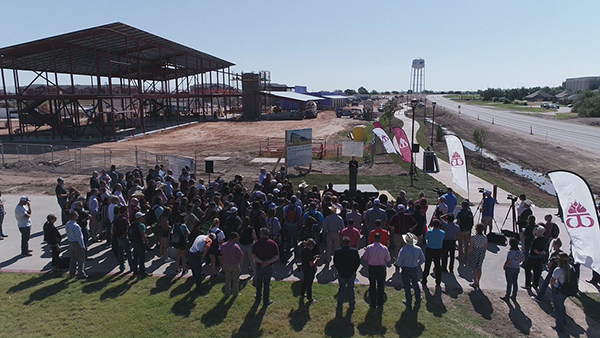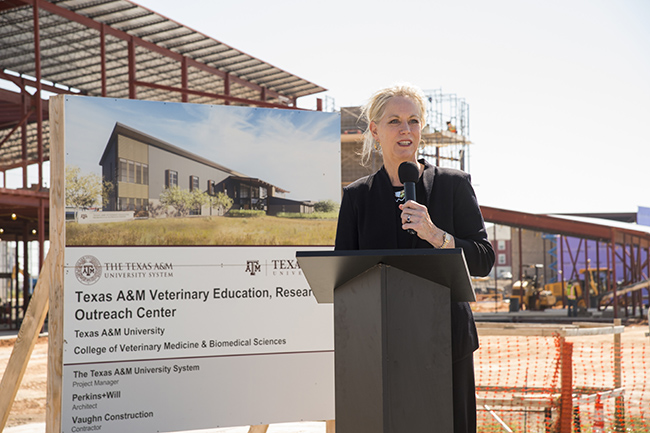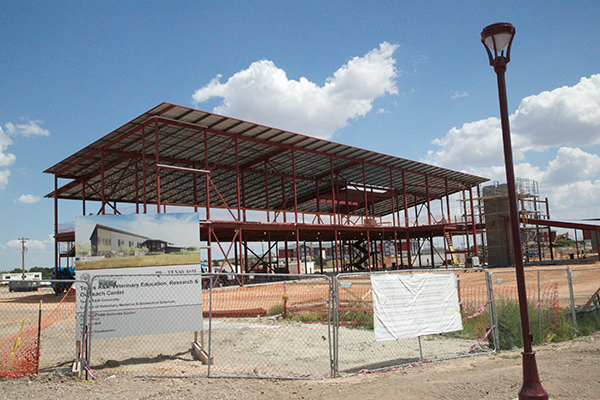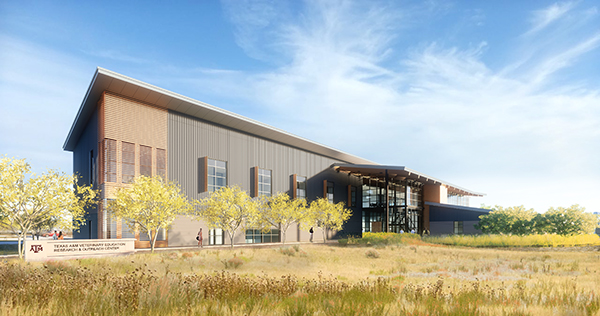Texas A&M University Brings Top-4 Veterinary Medicine Program to Texas Panhandle
Fourth-year veterinary students will begin clinical rotations in the Texas Panhandle in 2020, new students will begin enrolling in veterinary classes at VERO facility to start their first year of veterinary school in 2021.
To read the full text of Green’s speech, click here.

CANYON, Texas—Students from the Texas Panhandle won’t have to travel far from home to become Aggie veterinarians thanks to a new 2+2 program announced Thursday morning by West Texas A&M (WTAMU) and Texas A&M universities. Once all the necessary approvals have been obtained, veterinary students will be able to spend the first two years of their veterinary curriculum in Canyon on the WTAMU campus in the Veterinary Education, Research & Outreach (VERO) facility.
During a press conference at the construction site of the $22-million VERO facility being built on the WTAMU campus, WTAMU President Walter Wendler, Texas A&M President Michael Young, and the Carl B. King Dean of Veterinary Medicine at Texas A&M Eleanor M. Green discussed the decade-long plan to bring Texas A&M’s top 4-ranked Doctor of Veterinary Medicine (DVM) program to WTAMU through the VERO initiative.
Beginning May 2020, veterinary students wanting to work in food animal or mixed animal medicine will have the option of completing a number of new clinical rotations at the VERO facility in the Texas Panhandle, as part of their yearlong fourth-year clinical rotations.
“Texas A&M University has been committed to extending its nationally-ranked College of Veterinary Medicine & Biomedical Sciences to more effectively reach citizens across the expanse of Texas. An example of this is the VERO facility, funded through our Permanent University Fund,” Young said.
“The 2+2 program extends the reach of both Texas A&M and West Texas A&M, which is especially critical in an area that is home to the largest food animal production region in the nation,” he said. “Bringing excellent faculty here enhances the effectiveness of the college and opens new opportunities for students in the Texas Panhandle to become Aggie veterinarians.”

The Texas A&M College of Veterinary Medicine & Biomedical Sciences (CVM) is in the process of seeking approval for the 2+2 program, with a plan to open the application process in the fall of 2020 and begin offering DVM classes at WTAMU for an initial cohort of 20 first- and second-year DVM students beginning in the fall of 2021.
Through the 2+2 program, veterinary students will be able to take the classes during their first two years of veterinary school through the VERO program, a partnership between WTAMU and the CVM, and then travel to College Station for their final two years.
Those students won’t be gone for long, however; in their fourth year, those students will have the ability to return home for a number ofclinical rotations.
“The new clinical rotations in the Texas Panhandle will offer immediate engagement and additional unique and readily applicable experiences for DVM students who want to pursue food animal and production medicine as a career path,” Green said.
“These clinical rotations will provide students the opportunity to spend time in rural-practice settings with both private practitioners and Texas A&M faculty members,” she said. “Rotations will offer a chance to gain experience in the most important aspects of the industry in West Texas—including rotations through feedlots, dairies, and cow/calf, swine, and other livestock operations. Beginning in the spring 2021 semester, food animal students will also have the opportunity to spend clinical rotations in the Texas Veterinary Medical Diagnostic Laboratory (TVMDL), located in Canyon, where they will learn about diagnostic laboratory medicine, which is of critical importance to production animal health.”
In preparation to begin offering classes at WTAMU, the two universities have begun putting to use funds appropriated by the Texas Legislature during its 86th session by announcing the hiring of additional faculty members to teach in the program at the VERO facility.
“Over the next two years, at nearly $2 million a year, eight to 10 faculty will be hired through the legislative appropriations process to support new graduate student assistantships in the 2+2 program at West Texas A&M University,” Wendler said. “These students will seamlessly dovetail into the DVM program at Texas A&M University, which is one of the best in the nation.

“This program is twofold,” he continued. “It will prepare graduates for the food animal industry in one of the most concentrated meat and dairy production areas of the world, and it will train veterinary students to serve rural communities in support of WTAMU’s generational plan, WT 125: From the Panhandle to the World. Currently, our pre-vet program has more than 50 students.”
These faculty and graduate student additions to the CVM’s DVM program are just two of many rural and food animal-oriented programs the CVM has initiated over the past 10 years.
The Texas A&M University System has committed $90 million to the state agriculture industry on the WTAMU campus, including funds for the 22,000-square-foot VERO facility, which will house the 2+2 DVM curriculum, serve as a learning space to supplement the existing DVM externship programs and the new clinical rotations in the Texas Panhandle, as well as a regional veterinary teaching center that will facilitate collaborative, multidisciplinary research among scientists from across the region.
“We are grateful to the Texas legislators for investing in this program bound to be the best of its kind, as it advances the livestock industries, veterinary medicine, career opportunities for young people, and local economy,” Green said. “Our VERO team, which includes renowned food animal faculty members who are embedded at WTAMU, have strengthened our ‘Serving Every Texan Every Day’ initiative by facilitating the recruitment of veterinary school applicants with a mixed animal and large animal interest, doing impactful research, providing education, and serving the food animal industry.”
Team VERO and the Serving Every Texan Every Day memoranda of agreement with WTAMU has resulted in 23 DVM students in the CVM’s entering classes of ’21 and ’22 having been recruited from rural communities, many of whom came from the Texas Panhandle and West Texas A&M University.
In addition, Texas A&M graduates the highest number and percent of rural and mixed animal veterinarians in the nation, with 33 percent of the class of 2017 and 40 percent of the class of 2018 working in food animal and mixed animal practices in rural communities.
“We also are excited about the new DVM fourth-year clinical rotations and the new 2+2 program that will be offered in the Texas Panhandle and what these programs will bring to veterinary students in all four years of their curriculum; they will have exceptional opportunities to gain hands-on experience in rural and livestock veterinary medicine in the livestock epicenter of our nation,” Green said.

These new opportunities will dovetail nicely into existing livestock veterinary programs, like the long-standing Food Animal Production Tour, which recently reached a milestone of introducing its 100thstudent to these industries through an activity that showcases all of what the Texas Panhandle has to offer. In addition, the Food Animal & Rural Practice Summer Internship Program, initiated in 2017, has brought dozens of CVM students to the Panhandle to spend the summer gaining hands-on experience in the cattle, swine, and dairy industries, as well as in rural veterinary practices.
Finally, a $243,500 grant from the USDA’s National Institute of Food and Agriculture (USDA-NIFA) received by VERO director Dr. Dee Griffin in 2018 has allowed for the development, initiation, and support of seven veterinary-centered programs for veterinary students who travel to the Texas Panhandle for these opportunities.
For more information, contact the VERO program at 806-651-2292.
###
For more information about the Texas A&M College of Veterinary Medicine & Biomedical Sciences, please visit our website at vetmed.tamu.edu or join us on Facebook, Instagram, and Twitter.
Contact Information: Jennifer Gauntt, Interim Director of CVM Communications, Texas A&M College of Veterinary Medicine & Biomedical Science; jgauntt@cvm.tamu.edu; 979-862-4216


